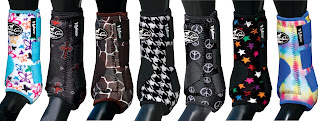To boot, or not to boot, becomes a frequently asked question. Opening any popular horse magazine or catalogue may overwhelm the reader with the diversity of equine protective leg wear. The right boot for you will be based on many factors--such as your horse’s conformation, movement, use, or even history.
There are many reasons to boot a horse, but the most important is prevention of injury. Although there have been many exciting advances in equine lameness diagnosis and treatment recently, tendon injuries are the most common injuries in performance horses, require long rest and rehabilitation periods, and have a high incidence of recurrence. Proper booting helps provide support to tendons, thus helping reduce tendon fatigue during work. Wear-and-tear accumulates from daily work and becomes a tendon injury.
Booting may also help to protect against contusions. Blunt trauma may occur due to the environment (rocks, jump poles, sliding, etc) or from the horse itself. Horses may over-reach with hind limbs and pull their shoes, bruise their soles, causing themselves to trip or fall, injure flexor tendons, or lacerate the heel bulbs. Forms of over-reaching include forging (same side hoof hits front foot), scalping, or cross firing. Another benefit of booting is to prevent against interference, or brushing, injuries. Interference is a term used to describe the limbs touching each other during foot flight. Horses may tend to interfere if they have conformation that is base narrow (narrow chest places limbs closer together), or toed-out. Toed-out conformation causes a horse to bring the limb toward mid-line during foot-flight, also called ‘winging.’ Booting may also protect against lacerations of the lower limb from any of these contusions, which are prone to develop exuberant granulation tissue (proud flesh).
There are many types of boots that perform different functions. Splint boots refer to boot that extend from below the knee or hock to the level of the fetlock or just below. If they are a simple form that wrap around the cannon bone (shin)- they are primarily used for brush control (see the Professional’s Choice Quick-Wrap®, Easy-Fit™, Competitor™, or VenTECH™ Splint Boots). If these splint boots extend down below the fetlock, they provide more support for the drop of the fetlock in weight bearing and support the tendon’s stretch (see the Professional’s Choice Ventech Elite, SMB II, or SMB 3). Bell boots refer to small cup shaped boots that fit around the pastern and over the hoof- these prevent injury to the hoof, hairline, or shoe pulling (see the Professional’s Choice Quick-Wrap®, Ballistic® Overreach, and Secure-Fit™ Overreach Bell Boots). Shipping boots extend from the ground to the level of the knee/hock or above and are used when transporting a horse in the trailer to prevent contusions. Alternatively- standing wraps with bell boots may be used for more support while stalled or during transport. Performance boots should not be used for support wraps during rest due to the lack of padding and horse’s sensitive limbs.
Booting may protect your horse against injury and ensure a long and comfortable performance career. There are many types of boots available on the market and many factors to take account of when making your decisions--please allow your veterinarian and trainer to help find the right product for your horse’s needs. Always remember, prevention is easier than rehabilitation!


You must login to post comments.